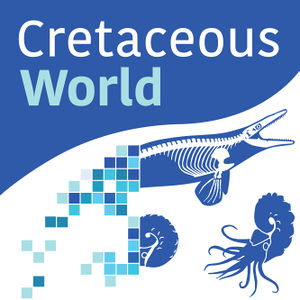The Cretaceous World: Difference between revisions
(→PENs) |
|||
| Line 66: | Line 66: | ||
=== Other project documentation === | === Other project documentation === | ||
== PENs == | == PENs == | ||
Digitization PEN: Expanding and enhancing a TCN digitizing fossils to reconstruct evolving ecosystems the Cretaceous Western Interior Seaway | |||
Revision as of 09:40, 23 August 2017
Digitization TCN: The Cretaceous World: Digitizing Fossils to Reconstruct Evolving Ecosystems in the Western Interior Seaway
| The Cretaceous World TCN | |
|---|---|
| Quick Links | |
| Project Summary | |
| Current Research | |
| Project Websites | |
| Network Map | |
| Publications | |
Project Summary
Between 65 and 100 million years ago, during the time that dinosaurs walked the earth, a large, tropical seaway covered the central part of what is now North America. This seaway teemed with marine life. Snails and clams lived on the seafloor; ammonites, along with giant mosasaurs, plesiosaurs, sharks, and fish, swam about; at the same time early birds and pterosaurs floated on or flew above the seaway. What remains today is a prolific fossil record that has been collected by paleontologists for over 100 years. Notable fossils from this time period and region are on display at museums around the world. However, the vast bulk of fossils collected from this region are locked away in museum drawers. To provide scientists and the general public access to these fossils and their associated data, this project proposes to digitize invertebrate and vertebrate fossils from this time period and region, making information accessible through searchable electronic databases. Additionally, a variety of online resources illustrating and describing these fossils and mapping their distributions will be developed. A freely accessible online textbook of paleontology will be generated and a website and App will be developed to highlight the appearances, occurrences, and ages of constituent species, to help students and aspiring paleontologists identify and learn about these fossils. The project plans to generate a variety of curricular materials for K-12 education, including 3-D scans of fossils for free download and printed 3-D models for classroom use. Products of this project will also include workshops to engage science teachers and items to augment public programs and exhibits at participating institutions.
This work will greatly increase the scientific value of eight major U.S. museum collections of fossils. The museum collections contain large amounts of data useful for studying what causes marine species to migrate, go extinct, and evolve during a long period of greenhouse climate conditions similar to those our planet may soon experience. These data have relevance for evaluating how global change has and will continue to affect life on earth. An estimated 164,000 specimens collected from thousands of locations, in the region once occupied by the Western Interior Seaway, will be databased and georeferenced. Representatives from each of roughly 1,500 microfossil, invertebrate, and vertebrate species will be imaged. The digitized records will be made available online via individual museum databases, iDigBio, and iDigPaleo. The resultant data will enable scientists to answer questions about how different species interact and ecosystems change in the face of environmental shifts during a key time in the history of life. Moreover, the data will be ideal for use with an assortment of modern quantitative tools -including paleoecological niche modeling (PaleoENM) - and will help improve paleoclimate and paleoceanographic models. Finally, several undergraduate and graduate students will be trained. Results of the project will be published at the following url: http://www.digitalatlasofancientlife.org.
Current Research
Proposed research uses of data generated through The Cretaceous World project include:
Project Websites & Social Media
Citizen Science & Outreach Projects
Project Leadership
Project sponsor: University of Kansas (NSF Award 1602067)
Principal Investigator (PI): Bruce Lieberman
Co-Principal Investigators: James Beach, K. Christopher Beard, Maribeth Price, Laurie Anderson
Project Collaborators
Map of Collaborating Institutions
American Museum Natural History - Neil Landman, Ruth O'Leary (NSF Award 1601891)
Fort Hays State University - Laura Wilson (NSF Award 1601944)
Paleontological Research Institute - Jonathan Hendricks (NSF Award 1645520)
San Jose State University - Jonathan Hendricks (NSF Award 1601790)
South Dakota School of Mines & Technology – Laurie Anderson, Maribeth Price
University of Colorado at Boulder - Talia Karim (NSF Award 1601729)
University of New Mexico - Corinne Myers (NSF Award 1601878)
University of Texas at Austin - Ann Molineux, Rowan Martindale, Matthew Brown (NSF Award 1602101)
Yale University - Susan Butts, Christopher Norris (NSF Award 1601884)
Protocols & Workflows
Publications
Professional Presentations
Other project documentation
PENs
Digitization PEN: Expanding and enhancing a TCN digitizing fossils to reconstruct evolving ecosystems the Cretaceous Western Interior Seaway
